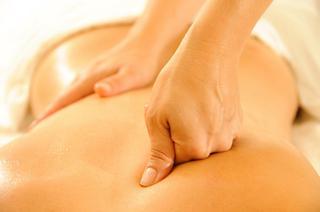
Deep Tissue Release, focuses on realigning deeper layers of muscles and connective tissue. It is especially helpful for chronically tense and contracted areas such as stiff necks, low back tightness, and sore shoulders.
Unlike Relaxation Massage Therapy, which is used for relaxation, deep tissue massage usually focuses on a specific problem, where there is chronic muscle tension or injury, there are usually adhesion's (bands of painful, rigid tissue) in muscles, tendons, and ligaments.
Deep tissue release massage works by physically breaking down adhesions. Adhesion's can block circulation and cause pain, limited movement, and inflammation. To do this the massage therapist uses direct deep pressure or friction applied across the grain of the muscles to relieve pain and restore normal movement.
Deep Tissue Release Massage can be extremely beneficial if you have been suffering with:
- Fibromyalgia
- Recovery from injuries (sports injury, falls, whiplash)
- Repetitive strain injury
- Postural problems
- Chronic pain
- Recovery from injuries
- Muscle tension or spasm
- Limited or lack of mobility
- Osteoarthritis pain
- Fibromyalgia Pain
Consumer reports poll ranked by 50,000 people indicated that Deep Tissue Massage was more effective in relieving osteoarthritis pain than physical therapy, exercise, prescription medications, chiropractic, acupuncture, diet, glucosamine and over the counter drugs.
Will Deep Tissue Massage Hurt?
- At certain points during the massage, most people find there is usually some discomfort and pain.
- It is important to tell the massage therapist when things hurt and if any soreness or pain you experience is outside your comfort range.
- There is usually some stiffness or pain after a deep tissue massage, but it should subside within a day or so. The massage therapist may recommend applying ice to the area after the massage.
What Can I Expect During My Visit?
Massage therapists may use fingertips, knuckles, hands, elbows, and forearms during the deep tissue release massage.
-
You may be asked to breathe deeply as the massage therapist works on certain tense areas.
-
It is important to drink plenty of water as you can after the massage to flush metabolic waste from the tissues.
Massage Is Not Recommended For Certain People:
- Immediately after surgery (6-12 months)
- Infectious skin disease, rash, or open wounds
- Immediately after chemotherapy or radiation, unless recommended by your doctor
- People with osteoporosis should consult their doctor before getting a massage
- Prone to blood clots. There is a risk of blood clots being dislodged. If you have heart disease, check with your doctor before having a massage
- Pregnant women should check with their doctor first if they are considering getting a massage.
- Massage should not be done directly over bruises, inflamed skin, unhealed wounds, tumors, abdominal hernia, or areas of recent fractures.
